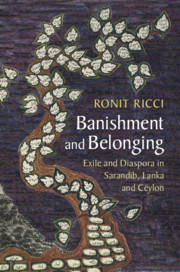Book contents
- Banishment and Belonging
- Asian Connections
- Banishment and Belonging
- Copyright page
- Contents
- Figures
- Maps
- A Note on Orthography and Manuscripts
- Acknowledgments
- Abbreviations
- Maps
- 1 Introduction
- 2 Diasporic Crossings: Malay Writing in Nineteenth-Century Ceylon
- 3 Remembering Java
- 4 “Ceyloned”: The View from the Other Shore
- 5 Exilic Journeys in Time, Place and Writing
- 6 Nabi Adam: The Paradigmatic Exile
- 7 Banishment and Interreligious Encounters: A Malay Ramayana
- 8 Ceylon Malays: Military and Literary Paths
- 9 Malay Writing in Ceylon: Roots and Routes
- Glossary
- Bibliography
- Index
5 - Exilic Journeys in Time, Place and Writing
Published online by Cambridge University Press: 11 November 2019
- Banishment and Belonging
- Asian Connections
- Banishment and Belonging
- Copyright page
- Contents
- Figures
- Maps
- A Note on Orthography and Manuscripts
- Acknowledgments
- Abbreviations
- Maps
- 1 Introduction
- 2 Diasporic Crossings: Malay Writing in Nineteenth-Century Ceylon
- 3 Remembering Java
- 4 “Ceyloned”: The View from the Other Shore
- 5 Exilic Journeys in Time, Place and Writing
- 6 Nabi Adam: The Paradigmatic Exile
- 7 Banishment and Interreligious Encounters: A Malay Ramayana
- 8 Ceylon Malays: Military and Literary Paths
- 9 Malay Writing in Ceylon: Roots and Routes
- Glossary
- Bibliography
- Index
Summary
The chapter continues dwelling on the theme, introduced in Chapter 4, of exilic life as depicted and remembered in Javanese texts, with an emphasis on (1) the challenges and emotional turmoil experienced by long-term exiles returning from Ceylon to Java and (2) a gendered perspective on exile and return. The former is explored primarily through the textual testimonies narrating the return of Pangeran Juru, previously known as Natakusuma, who was the chief council to King Pakubuwana II until he was banished in 1742. Depictions of his return after more than a decade in exile provide evidence of the transformative effects of the experience and the struggle to reintegrate into court life. As for gender, the chapter argues that, although women’s voices recounting exile are even rarer than men’s, it is women who tend to deliver the more detailed, emotional and thus revealing accounts. It is also their exilic lives whose traces tend to come to us through narrations of marriage, love relationships, widowhood and divorce, bringing out more fully the human dimension of living through exile and return.
- Type
- Chapter
- Information
- Banishment and BelongingExile and Diaspora in Sarandib, Lanka and Ceylon, pp. 97 - 124Publisher: Cambridge University PressPrint publication year: 2019



